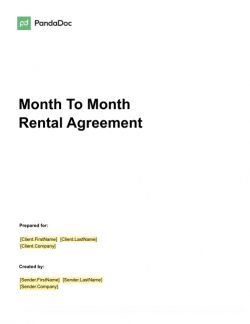Utah Month-to-Month Lease Agreement
Utah has specific laws governing landlord-tenant relationships, and our Month-to-Month Lease Agreement Template for Utah is designed to align with these legal requirements. This template includes essential details such as rent terms, property rules, and termination clauses.

Month-to-Month Leases in Utah
Lessors have various disclosure and legal terms they must add in a Utah month-to-month lease agreement if they want the contract to be valid in a court of law. Below, there are the basic terms and statutes concerning clauses like the lease’s termination, security deposits, and tenant rights.
Lease Termination & Renewal
- Utah lessors and lessees can terminate an agreement with 15 days’ notice.
- It must be a written notice sent to the other party using reliable methods. These methods include hand-delivering it or using a certified mail system.
- There are no renewal terms in the document, as the lease continues until one party initiates the termination process.
Rent Increases
- There’s no statute governing the notice period for a rent increase. Most landlords stick with the 15-day notice period.
- Lessors can raise the rental amount as they choose since there are no rent control laws and the state prevents local governments from creating rent control laws.
Security Deposit
- A security deposit may only equal up to one month’s rent.
- The lessor must conduct move-in and move-out inspections.
- Once the landlord deducts any damages beyond the standard wear and tear, they must return the security deposit within 30 days.
- An itemized statement of deductions should accompany it. Should the tenant disagree with the deductions, they can pursue mediation or take legal action to dispute it.
Tenant Rights
- Lessees have the right to a safe rental unit that satisfies all the local housing laws. If there are any damages the tenant didn’t cause that stand in the way of a habitable unit, then they can request repairs.
- If the landlord doesn’t respond within three (3) days of the notice on how they’ll fix the issue, then the renter can solve it themselves.
- The lessee can deduct reasonable costs of the repairs from their next month’s rent if the lessor doesn’t fix it.
- The repairs cannot cost more than two months’ rent. If it’ll cost more than that, it’s better for the tenant to seek legal advice.
Required Disclosures
The following disclosures must be present in the agreement:
- Methamphetamine Contamination: Lessors must inform tenants if their rental unit is in any way contaminated by meth production, usage, or storage.
- Agent Identification: The landlord must provide the authorized agent’s contact details for legal notices. These details generally include their name and address.
- Rules and Regulations: All agreements must include a copy of the property’s rules and regulations.
- Lead-Based Paint: The lessor must disclose the presence and risks of lead-based paint if the building is older than 1978.
- Property Condition Report: Before moving in, the landlord must provide the tenant with an inventory of the unit’s condition.
New Tenant Disclosure: The landlord must provide any crucial information a tenant needs that doesn’t fall under any other disclosures, like an estimate of the rent and non-rent costs.

